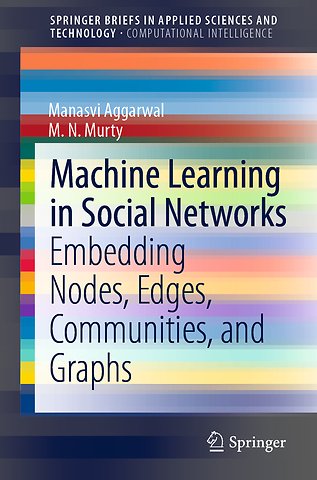Machine Learning in Social Networks
Embedding Nodes, Edges, Communities, and Graphs
Samenvatting
This book deals with network representation learning. It deals with embedding nodes, edges, subgraphs and graphs. There is a growing interest in understanding complex systems in different domains including health, education, agriculture and transportation. Such complex systems are analyzed by modeling, using networks that are aptly called complex networks. Networks are becoming ubiquitous as they can represent many real-world relational data, for instance, information networks, molecular structures, telecommunication networks and protein–protein interaction networks. Analysis of these networks provides advantages in many fields such as recommendation (recommending friends in a social network), biological field (deducing connections between proteins for treating new diseases) and community detection (grouping users of a social network according to their interests) by leveraging the latent information of networks. An active and important area of current interest is to come out with algorithms that learn features by embedding nodes or (sub)graphs into a vector space. These tasks come under the broad umbrella of representation learning. A representation learning model learns a mapping function that transforms the graphs' structure information to a low-/high-dimension vector space maintaining all the relevant properties.
Specificaties
Inhoudsopgave
<p>1.1 introduction </p>
<p>1.2 Notations used in Book </p>
<p>1.3 Contents covered in this book<br> </p>
<p>2 Representations of Networks </p>
<p>2.1 Introduction </p>
<p>2.2 Networks Represented as Graphs </p>
<p>2.3 Data Structures to Represent Graphs </p>
<p>2.3.1 Matrix Representation </p>
2.3.2 Adjacency List <p></p>
<p>2.4 Network Embeddings </p>
<p>2.5 Evaluation Datasets </p>
<p>2.5.1 Evaluation Datasets </p>
<p>2.5.2 Evaluation Metrics </p>
<p>2.6 Machine Learning Downstream Tasks </p>
<p>2.6.1 Classification</p>
2.6.2 Clustering<p></p>
<p>2.6.3 Link Prediction (LP) </p>
<p>2.6.4 Visualization </p>
<p>2.6.5 Network Reconstruction</p>
<p>2.7 Embeddings based on Matrix Factorization </p>
<p>2.7.1 Singular Value Decomposition (SVD) </p>
<p>2.7.2 Matrix Factorization based Clustering </p>
2.7.3 Soft Clustering as Matrix Factorization <p></p>
<p>2.7.4 Non-negative Matrix factorization (NMF) </p>
<p>2.8 Word2vec </p>
<p>2.8.1 Skipgram model </p>
<p>2.9 Learning Network Embeddings</p>
<p>2.9.1 Supervised Learning </p>
<p>2.9.2 Unsupervised Learning</p>
2.9.3 Node and Edge Embeddings <p></p>
<p>2.9.4 Graph Embedding </p>
<p>2.10 Summary<br> <br> </p>
<p>3 Deep Learning </p>
<p>3.1 Introduction </p>
<p>3.2 Neural Networks </p>
<p>3.2.1 Perceptron</p>
<p>3.2.2 Characteristics of Neural Networks </p>
<p>3.2.3 Multilayer Perceptron Networks</p>
<p>3.2.4 Training MLP Networks</p>
3.3 Convolution Neural Networks <p></p>
<p>3.3.1 Activation Function</p>
<p>3.3.2 Initialization of Weights </p>
<p>3.3.3 Deep Feedforward Neural Network</p>
<p>3.4 Recurrent Networks </p>
<p>3.4.1 Recurrent Neural Networks </p>
<p>3.4.2 Long Short Term Memory </p>
3.4.3 Different Gates used by LSTM<p></p>
<p>3.4.4 Training of LSTM Models </p>
<p>3.5 Learning Representations using Autoencoders </p>
<p>3.5.1 Types of Autoencoders </p>
<p>3.6 Summary</p>
<p>References <br> <br> </p>
<p>4 Embedding Nodes and Edge</p>
<p>4.1 Introduction </p>
<p>4.2 Representation of Node and Edges as Vectors </p>
<p>4.3 Embeddings based on Random Walks </p>
4.4 Embeddings based on Matrix Factorization<p></p>
<p>4.5 Graph Neural Network Models</p>
<p>4.6 State of the art algorithms </p>
<p>4.7 Evaluation methods and Machine Learning tasks </p>
<p>4.8 Summary </p>
<p>References <br> <br> </p>
<p>5 Embedding Graphs</p>
<p>5.1 Introduction </p>
<p>5.2 Representation of Graphs as Vectors</p>
<p>5.3 Graph Representation using Node Embeddings </p>
5.4 Graph Pooling Techniques <p></p>
<p>5.4.1 Global Pooling Methods</p>
<p>5.4.2 Hierarchical Pooling Methods </p>
<p>5.5 State of the art algorithms </p>
<p>5.6 Evaluation methods and Machine Learning tasks </p>
<p>5.7 Summary</p>
References
Net verschenen
Rubrieken
- aanbestedingsrecht
- aansprakelijkheids- en verzekeringsrecht
- accountancy
- algemeen juridisch
- arbeidsrecht
- bank- en effectenrecht
- bestuursrecht
- bouwrecht
- burgerlijk recht en procesrecht
- europees-internationaal recht
- fiscaal recht
- gezondheidsrecht
- insolventierecht
- intellectuele eigendom en ict-recht
- management
- mens en maatschappij
- milieu- en omgevingsrecht
- notarieel recht
- ondernemingsrecht
- pensioenrecht
- personen- en familierecht
- sociale zekerheidsrecht
- staatsrecht
- strafrecht en criminologie
- vastgoed- en huurrecht
- vreemdelingenrecht
